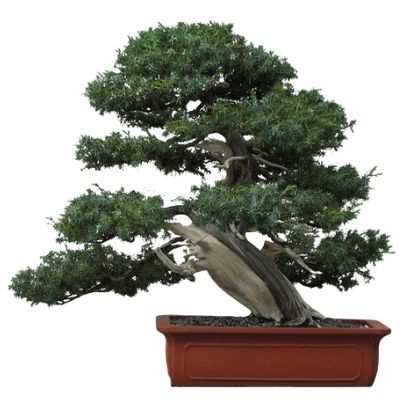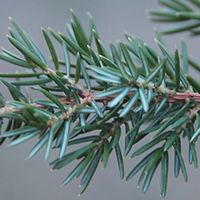
Needle Juniper
(Juniperus rigida)
Country of Origin : Korea, Japan and Northern China
Bonsai Styles : Informal upright, Formal upright
Zone : 6 – 9
Needle juniper also known as ‘temple juniper‘ and ‘Tosho‘, is a hardy, fast growing and evergreen tree.
Its common name is derived from its fine, needle-like leaves. It is also called temple juniper because of its spiritual significance in Japan.
A yellow-brown peeling bark covers the trunk of needle juniper, and the leaves are needle-like and bright green, with a dark blue-gray line along the dorsal groove.
You can gently brush away the flaky outer bark to reveal the orange-red underbark, which contrasts beautifully with the silver-gray driftwood and soft green foliage.
Young shoots are flaccid and droop downward. Japanese bonsai enthusiasts love this small tree with gracefully arching branches.
Growing male and female needle juniper trees together during the flowering season will result in female needle juniper trees producing green berries that ripen into purple-black berries in almost two years.
As opposed to its cousins, Juniperus rigida has needle-like leaves arranged in groups of three on slender stems.
Juniperus communis is another needle juniper that is attractive.

Needle like leaves of Juniperus rigida bonsai tree.
Best location to keep Needle Juniper Bonsai
The needle juniper bonsai tree thrives in full sun. It is fully hardy in temperate zones.
If needle juniper bonsai tree is grown in shade, its shoots will become leggy. Due to this, the shoots are unable to carry their own weight and are likely to die back.
Try to keep the bonsai pot at a location where the roots of the needle juniper bonsai tree are protected from hot sun in mid summer.
During the winter, prevent the foliage from turning brown by ensuring that the roots are not damaged by prolonged or severe freezing. It might be too late to deal with root problems by the time you become aware of them.
It is advisable to move plants into a frost-free shed during winter when temperatures drop below 14°F (-10°C).
Refer sunlight requirements for indoor plants for more indoor plant placement ideas.
Propagation of Needle Juniper
Needle juniper tree can be propagated with stratified seeds in spring.
It can also be propagated in summer using softwood cuttings.
Watering Needle Juniper Bonsai
During the growing season, water the Needle juniper bonsai tree well.
Water generously in the summer season. Spraying mist on the foliage during summer also helps the bonsai tree to be healthy.
Between every watering session, let the soil surface dry slightly. However, do not allow the bonsai soil to dry out entirely.
Avoid watering during winter, but make sure soil stays moist.
Make sure that the soil is not waterlogged. This will prevent the roots from rotting.
Wiring Needle Juniper Bonsai
Needle juniper bonsai tree can be wired anytime between fall and early spring. However, make sure that none of the needles are trapped under the wire.
You can leave the wires in place until the required shape has been obtained, but be careful not to let them cut into the bark.
Raffia can be wrapped around the branch if it is very thick and at risk of snapping or if you wish to avoid wire marks.
On thicker branches, wires may need to be left in place for up to two years before the branches begin to set.
Pruning Needle Juniper Bonsai
When to prune Needle juniper bonsai?
How to prune Needle juniper bonsai?
Early spring is the preferred time to prune back old wood.
Be careful not to cut through the needles. Just cut above a cluster of needles.
Avoid pruning the tree when the needle juniper bonsai tree is repotted.
You can perform thinning of congested foliage in the time of summer.
Provided that there is no chance of frost, you can prune branches at any time.
The stubs of pruned branches can be shaped into jins, or two jins can be linked by a shari.
Undersides of branches should be cleaned of all foliage.
Branches that are too vigorous should be cut back to three or four needles.
To prevent the inner branch die-back, prune the bonsai to let light into the lower and inner branches.
Pinching Needle Juniper Bonsai
To maintain shape, pinch out the growing tips as needed with your fingers. This can be done throughout the growing season.
To keep a neat outline, pinch down all the growing tips with your fingers.
To cut back or remove aggressive extension shoots, they should be cut as close to a healthy side shoot as possible.
Repotting Needle Juniper Bonsai
When to repot Needle juniper bonsai?
Repotting of needle juniper bonsai tree can be done in early to mid spring.
Repot needle juniper bonsai tree every 2 years. However, when the tree becomes 10 years old, you can repot the needle juniper bonsai tree every 5 years or so.
If the roots still have room to expand in the bonsai pot, do not repot the tree.
When repotting, do not prune more than 1/3 of the roots.
You can use a soil mix mixed with 20% finely chopped fresh sphagnum moss
OR
You can also use one part Akadama and one part coarse grit.
OR
You can also use a mix of 60% grit and 40% organic material.
Must Read: Bonsai Soil Recipes
Must read : Choosing the right bonsai container
Feeding Needle Juniper Bonsai
Early in the spring, apply a high-nitrogen fertilizer. From early summer until late summer, apply a general fertilizer once a month. In the fall and winter, do not fertilize needle junipers.
OR
During the growing season, use half-strength balanced feed. In fall, apply nitrogen-free. Adding half-strength slow-release balanced feed in midwinter will boost spring growth.
Diseases and pest of Needle Juniper Bonsai
Insects such as scale insects, small caterpillars and red spider mites can be problematic.
By spraying a jet of water on the needle juniper bonsai tree, you can remove the pests. However, if the infestation is serious, you can use a systemic insecticide.
Rarely the needle juniper tree can be afflicted by difficult to diagnose fungal infection that can kill the tree if allowed to spread. Pruning the affected area can be done to take care of the fungal problem.
Needle Juniper bonsai care
The junipers turn yellow or brown when exposed to frost. While it is not aesthetically pleasing, it does not harm the tree.
The bonsai will turn green again when spring arrives.
Trees such as needle junipers are notorious for dying for no apparent reason. There is always a reason however. The metabolism of needle juniper bonsai tree is slow.It can take up to twelve months for root problems to affect the foliage. By the time the problem is discovered, the tree may be beyond repair. Hence, be very careful while watering and take care of bonsai soil quality.
Branches with discolored foliage that cannot be attributed to spider mites or scale insects should be pruned back to a healthy state.
Since the young shoots are so slender, allowing them to grow too long can sometimes make a bonsai seem untidy. Hence, regular pruning and pinching is required.
While young, the branches are flexible, however it grows more brittle with age. Before you wire an old branch, you should test it gently. If it seems a bit stiff, move it bit by bit each week over several months.
Each needle has a dormant bud at its base. The buds extend as the pruning becomes more pronounced. This eventually results in crowded foliage which attracts fungal spores and spider mites. Pruning the older twigs from the outer ends once a year will prevent this from happening. As time goes on, new shoots will replace the pruned twigs, and the cycle continues.
What to look for when buying Needle Juniper Bonsai
Choose a bonsai tree with a strong, striking trunk with driftwood that looks natural.
A needle juniper bonsai tree with overcrowded foliage should be avoided.
Make absolutely sure that the roots of the needle juniper bonsai tree are healthy and are holding the bonsai container firmly.
Any root problems detected later will be hard to resolve.


1 comment
I was looking at some of your posts on this website and I conceive this internet site is really instructive! Keep putting up.